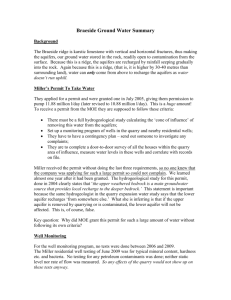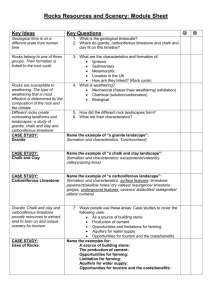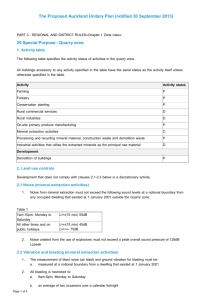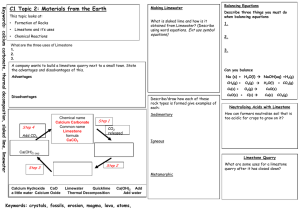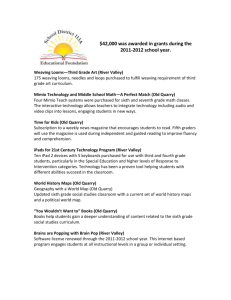The steam shovels of the Geelong Cement works
advertisement
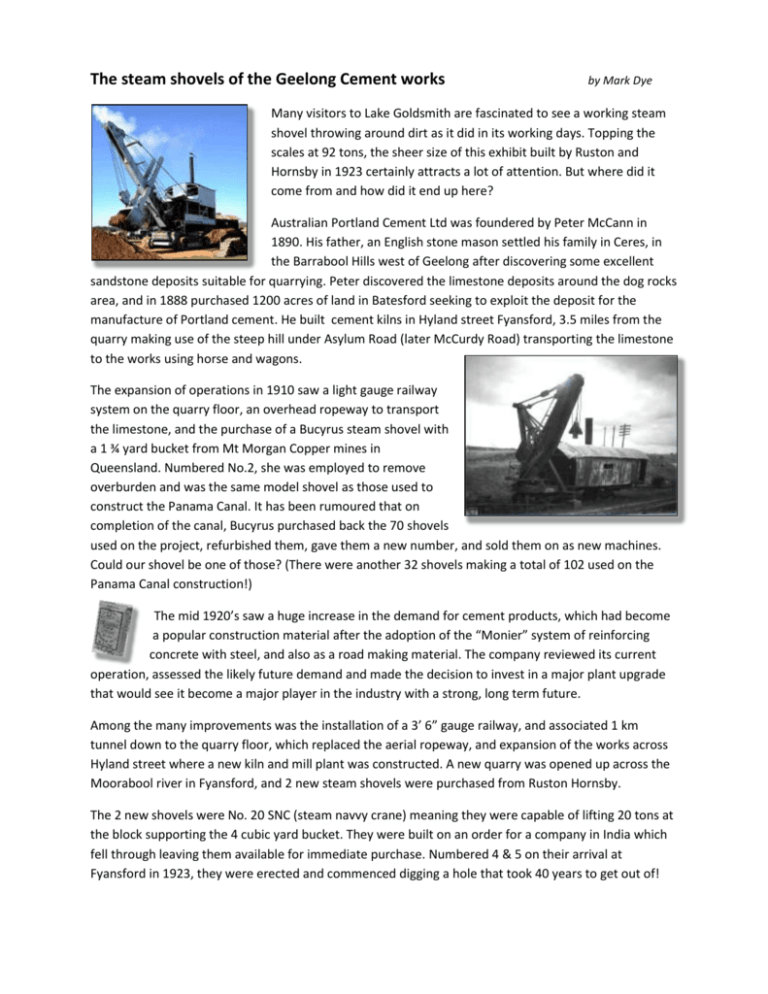
The steam shovels of the Geelong Cement works by Mark Dye Many visitors to Lake Goldsmith are fascinated to see a working steam shovel throwing around dirt as it did in its working days. Topping the scales at 92 tons, the sheer size of this exhibit built by Ruston and Hornsby in 1923 certainly attracts a lot of attention. But where did it come from and how did it end up here? Australian Portland Cement Ltd was foundered by Peter McCann in 1890. His father, an English stone mason settled his family in Ceres, in the Barrabool Hills west of Geelong after discovering some excellent sandstone deposits suitable for quarrying. Peter discovered the limestone deposits around the dog rocks area, and in 1888 purchased 1200 acres of land in Batesford seeking to exploit the deposit for the manufacture of Portland cement. He built cement kilns in Hyland street Fyansford, 3.5 miles from the quarry making use of the steep hill under Asylum Road (later McCurdy Road) transporting the limestone to the works using horse and wagons. The expansion of operations in 1910 saw a light gauge railway system on the quarry floor, an overhead ropeway to transport the limestone, and the purchase of a Bucyrus steam shovel with a 1 ¾ yard bucket from Mt Morgan Copper mines in Queensland. Numbered No.2, she was employed to remove overburden and was the same model shovel as those used to construct the Panama Canal. It has been rumoured that on completion of the canal, Bucyrus purchased back the 70 shovels used on the project, refurbished them, gave them a new number, and sold them on as new machines. Could our shovel be one of those? (There were another 32 shovels making a total of 102 used on the Panama Canal construction!) The mid 1920’s saw a huge increase in the demand for cement products, which had become a popular construction material after the adoption of the “Monier” system of reinforcing concrete with steel, and also as a road making material. The company reviewed its current operation, assessed the likely future demand and made the decision to invest in a major plant upgrade that would see it become a major player in the industry with a strong, long term future. Among the many improvements was the installation of a 3’ 6” gauge railway, and associated 1 km tunnel down to the quarry floor, which replaced the aerial ropeway, and expansion of the works across Hyland street where a new kiln and mill plant was constructed. A new quarry was opened up across the Moorabool river in Fyansford, and 2 new steam shovels were purchased from Ruston Hornsby. The 2 new shovels were No. 20 SNC (steam navvy crane) meaning they were capable of lifting 20 tons at the block supporting the 4 cubic yard bucket. They were built on an order for a company in India which fell through leaving them available for immediate purchase. Numbered 4 & 5 on their arrival at Fyansford in 1923, they were erected and commenced digging a hole that took 40 years to get out of! No. 4 Face shovel loading trucks in the new quarry in 1930, - the hole that took 40 years to get out of! These 2 new shovels, were the latest technology requiring a scant crew of only 4 men; much better than the 7 men needed to operate the Bucyrus shovel! In the advertising material, it was bragged by RH that their shovel could do the work of 100 men! (Of course with today’s modern hydraulic systems, the same machine can be worked much more quickly, and needs only 1 man) The 2 steam shovels worked tirelessly loading limestone into railway wagons until they’re final job on the quarry floor, was the sad task of building up their replacements, 2 new “Marion” diesel shovels in the 1950’s. No.4 was then moved up to work the overburden for a few years, while No.5 was given a special job. She was fitted with a second hand clam shell dredge bucket that had been purchased as surplus from the Geelong Harbour Trust, and fired up once per year to dredge the sandy silt from the quarry drainage pond near the railway tunnel mouth, where the quarry de-watering pumps took suction, 21 meters below sea level. When I began work at the quarry in the early 1980’s, the Bucyrus shovel had sat motionless since the 1960’s opposite the quarry manager’s top office, having being retired early in its life after the boiler inspector discovered an irreparable crack in the firebox of the locomotive boiler. It was only used occasionally on compressed air as a crane over the rail lines when needed. No.4 RH shovel sat at the top by the road leading into the quarry, while No.5 still sat beside the pond on the quarry floor. Credit must be given to the then quarry manager, Max Parker who had the foresight not to let these machines be scrapped, and a fellow worker once told me that old Max was mad, because one day when the crusher broke down, and the workers had nothing to do, he made them paint the old steam shovels with sump oil! (A mad plan to some, but thankfully he could see they still had a future) Quarries are never a static affair, and as time went by the old shovels found themselves in the way of progress. No.4 was the first as the quarry expanded and was donated to Lake Goldsmith Steam Preservation Co-op in the early 1980’s where she is currently preserved and in operation at the bi-annual steam rally, and an impressive sight when seen in operation. The Geelong Cement works found themselves in a tough competitive market, and finally ceased operation in 2000, after 110 years when the parent company deciding to import cement from their plant in Tasmania. The limestone quarry however, was kept open by the McCann family and today is used for agricultural lime. At this time, No.5 RH shovel was given to a team from “Campbelltown steam & machinery museum” and transported to their site South of Sydney, where she sat awaiting re-assembly. Below: The shovels at Lake Goldsmith, Ruston Hornsby (left) and the Bucyrus Shovel shortly after arrival (right). No.2 Bucyrus shovel too, eventually blocked quarry expansion, and was also donated to Lake Goldsmith. The McCann family, who have a history of involvement with vintage machinery have also recently donated a sum of money towards the restoration of the machine. Since arriving at the lake, she has undergone some major boiler refurbishment, and with modern welding techniques that exist today, the firebox crack that almost caused the demise of the entire machine, has been ground out and welded back up to the satisfaction of the boiler inspector. Preparations are underway to have her in operation for the 100th rally in November 2012. Nothing much happened to No.5 during it’s time in NSW, and was recently returned to Victoria when the club realised they had didn’t have the resources required to progress the restoration of this large machine. So early in 2012, she arrived at the grounds of the Melbourne Steam Traction Engine club in Scoresby Victoria as a large number of dismembered parts, and a plan is being mooted for her reassembly to be displayed alongside the clubs huge electric drag line in the main arena. Below: No.5 shovel Thanks must be given for the invaluable information used in this article, supplied by the Geelong Cement Retiree’s Museum with their amazing collection of artifacts of all descriptions. It’s located south end of McCurdy Road, Herne Hill, Geelong. (Top of Autumn Street). A visit is well worth the effort! Mention should also be made of the 100th Lake Goldsmith Steam rally, November 3rd, 4th, & 5th 2012. This 3 day event not to be missed! Mark Dye


